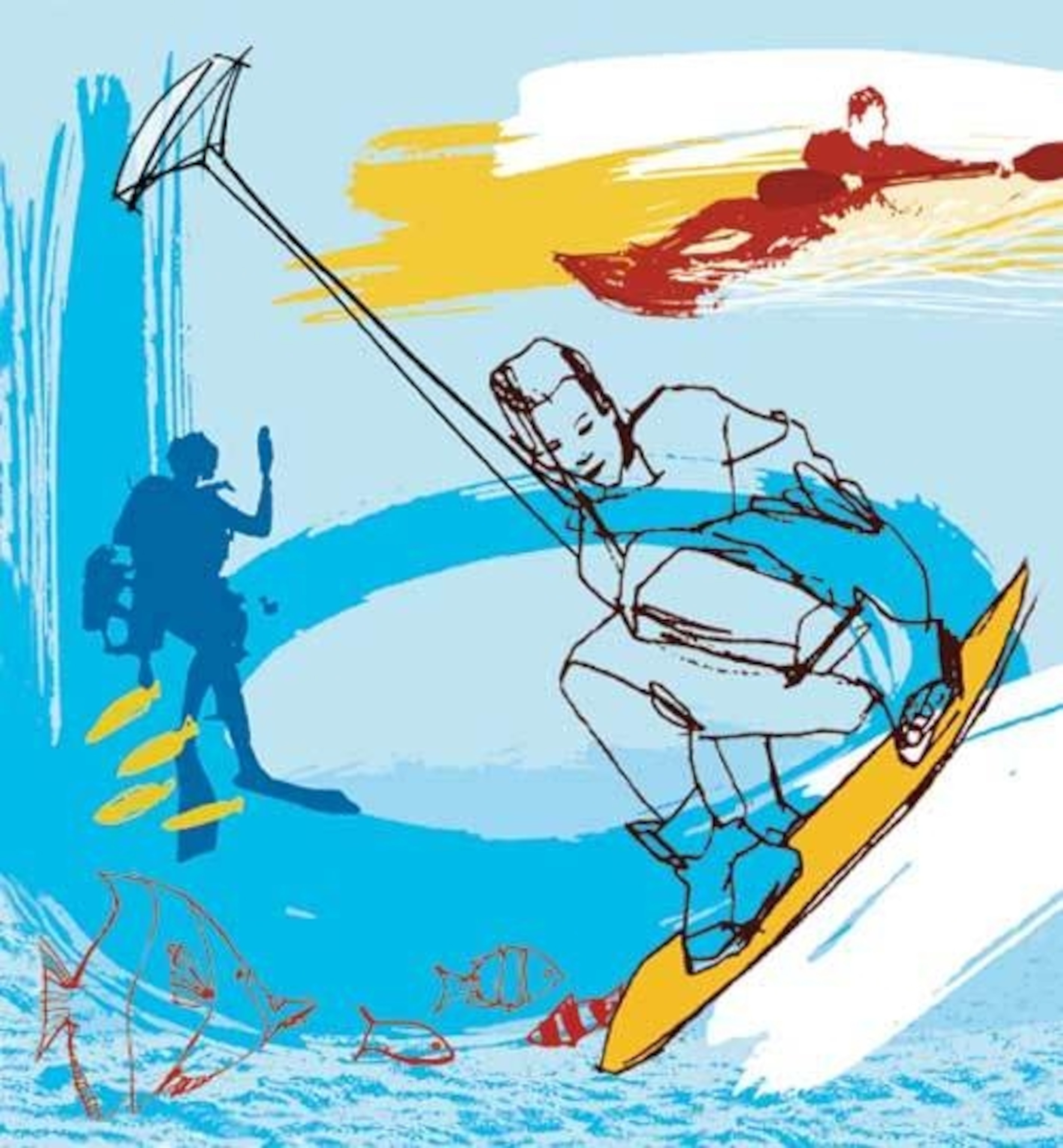
Jellyfish Invasions! Rip Tides! Shark Attacks! Six Beach Dangers (and How to Void Them)
Text by Christopher Percy Collier and Devon O’Neil
Illustration by Kate Miller
The lures of the beach are hard to resist come summer. But this season a raft of perils (Shark attacks! Riptides! Jellyfish invasions!) seems poised to storm the coast and shift the action from surfing and sea kayaking to chicken fights and Marco Polo at the community pool. Last year, in fact, saw more than 25,000 beach closings or swimming advisories—a 28 percent increase from 2006, according to the Natural Resources Defense Council. What’s more alarming is that an estimated seven million people get sick every year after visiting the nation’s 3,500 beaches. But that’s no reason to forsake the sand. Here, what the experts say is lurking at the shore—and how you can maximize your time in the sun.
1. STING OPERATION
Plagues of jellyfish are nothing new, but this summer may well be the worst ever, and we have only ourselves to blame: Overfishing has left fewer predators, and global warming has brought on ideal breeding conditions. The Mediterranean is expected to be the jelly hot spot, but populations will likely spike in oceans worldwide. The sting of Australian jellies can be fatal, but those found off North American coasts usually aren’t deadly: “You’re just in for a few painful hours. But if you have difficulty breathing or develop hives, get to a doctor ASAP,” advises Suzanne M. Shepherd, M.D., of the University of Pennsylvania’s PENN Travel Medicine Clinic.
ACTION PLAN: Rinse the area with ocean salt water, then apply vinegar. Flushing it with fresh water—or urine—will only make the sting worse.
2. BIG FISH
“You’re far more likely to be attacked by the family dog than by a shark,” says Marie Levine, executive director of the Shark Research Institute, but attacks on humans off U.S. shores seem to be on the rise. In the entire 20th century 108 Pacific coast attacks were reported; the new millennium has already seen 38, including nine last year, equaling the record high set in 2004.
ACTION PLAN: Avoid high-contrast color swimsuits, stay away from sandbars and mouths of rivers, and check out sharkattackfile.net for more tips. High-risk areas to consider avoiding include Florida’s New Smyrna Beach (the so-called shark-bite capital of the world) and California’s Tomales Point and Monterey Bay—both
are known great white hangouts.
3. BLANKET ENDORSEMENT
Go ahead and get some sand between your toes, but take your rest breaks on a towel. Beach closures are typically determined solely by water quality tests, but new research suggests the sand may be suspect too. A 2007 Nova Southeastern University study of Florida beaches turned up higher amounts of bacteria in the sand than in the water, which could lead to stomach trouble for visitors.
ACTION PLAN: “I love the beach; nothing’s going to stop me from going,” says Tonya D. Bonilla, one of the 2007 study’s authors. Still, rinse off in a beachside shower after swimming, if you can, and avoid sitting in wet sand or the surf for extended periods of time
4. STORM SURGE
Any surfer worth his salt knows that storms bring on the best wave conditions, but hard rains can also sweep debris and sewage into the ocean. The resulting pathogens can linger for up to three days; water safety tests can take that long just to reach the public. And looks are deceiving: The H20 might seem clear and enticing even if it’s dangerously polluted.
- National Geographic Expeditions
ACTION PLAN: They may be convenient, but urban beaches are, shall we say, less than pristine. Head to rural stretches of sand whenever possible. If city-center waves are your only choice, then try to “avoid going three days after a hard rain,” says Ryan Dwight, Ph.D., director of the Coastal Water Research Project. While you’re waiting for the tide to clear, pitch in at a beach cleanup with Surfrider Foundation.
5. TIDE CHANGE
Rip currents are responsible for 80 percent of beach rescues and some hundred deaths a year. “No matter how competent you are, panic can set in,” says United States Lifesaving Association President B. Chris Brewster. “If you try to swim against the current, you can get tired pretty fast.”
ACTION PLAN: Rips are hard to spot, but try to avoid areas with their telltale signs: floating debris and extremely foamy water. If you do get caught up, stay calm and signal for rescue—or swim parallel to the shore.
6. THE NEW WAVE
Looking for new surf spots? Then head to the Midwest: With 11,530 miles of shoreline (more than the Atlantic and Pacific coasts combined), the Great Lakes are the country’s new boarding epicenter. Get started at Michigan’s Third Coast Surf Shop (thirdcoastsurf
shop.com). Another landlocked option: Find a fresh stoke at one of the U.S.’s ridable rivers (2imagine.net). Otherwise, jump on the ever growing stand-up paddle surfing bandwagon: “I started shaping four paddleboards a month in 2006,” says big-wave rider Blane Chambers. “Now I’m up to a hundred a month. I’m sending boards all over the world.”
